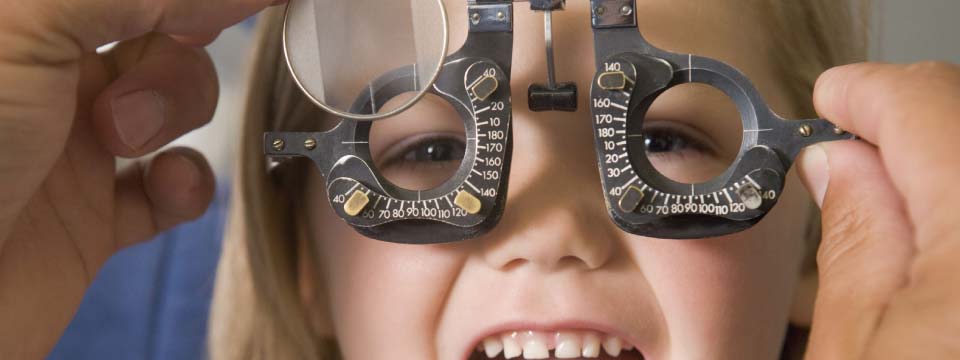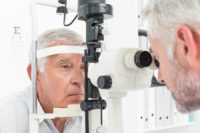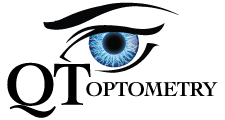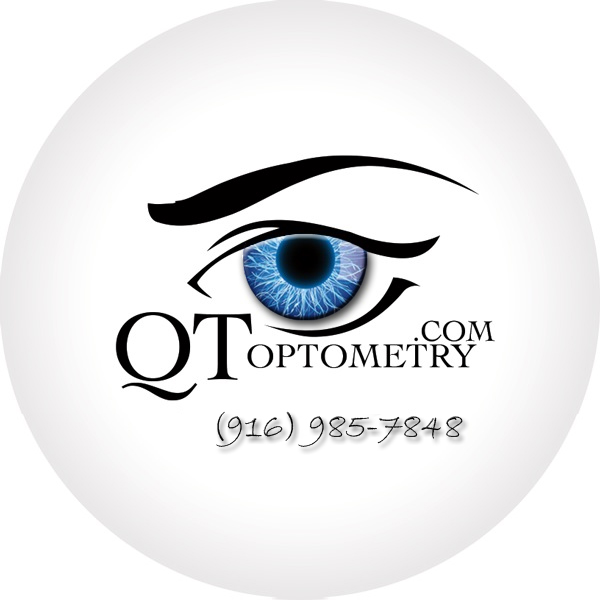The Importance of An Annual Wellness Evaluation
Regular annual wellness exams throughout life is an important factor, however, it’s not always for the same reason. Just as your body require annual maintenance and care, so do your eyes. Find out why an annual wellness exam is an important part of your healthcare routine.
Dr. Q recommends that your child have a pediatric eye exam starting at six months of age. With more than 100 different ways to test whether the eyes are working correctly, Dr. Q will select the tests that are most appropriate for your child’s needs. The eye exam not only provides an accurate assessment of his or her ability to see, but also gauges general eye health – and can result in early identification of other eye problems such as amblyopia (lazy eye), strabismus (eye turn), astigmatisms, hyperopia (farsightedness), myopia (nearsightedness), and many others.
When Should a Pediatric Exam Occur?
Visual perception and vision development starts at birth and continues to be honed throughout the preschool years in your child. These critical periods are the foundation for their visual abilities, in school and throughout their lives. Parents should be especially vigilant during these years in order to ensure vision is progressing as it should. Scheduling regular pediatric eye exams should be part of your action plan for providing your child with this strong foundation. By the age of three, your child should have a comprehensive eye exam to ensure his or her vision is developing normally and is absent of any eye disease. If there are no significant findings after this critical pediatric exam, your child will not need to be evaluated again until the age of five. Dr. Q will then compares the test results of the two examinations, so that he can get an accurate picture of how your child’s vision is developing before the school years begin.
Vision screenings administered by a child’s school or pediatrician offices are NOT the same as a comprehensive eye examined by Dr. Q. Research has shown that vision screenings can miss as much as 60% of children with vision problems or some form of visual disorder. Treatment of childhood eye diseases has been found to be most successful at early ages, usually before eight years old. Some treatment may include eye glasses, patching, eye drops, or even eye surgery.
What Signs Should Parents Look for that Eye Attention is Needed?
The American Optometric Association offers the following list of signs to watch for that could mean that your child has a vision problem:
- Sitting close to the TV or holding a book too close.
- Squinting.
- Tilting their head.
- Frequently rubbing their eyes.
- Short attention span for the child’s age.
- Turning of an eye in or out.
- Sensitivity to light.
- Difficulty with eye-hand-body coordination when playing ball or bike riding.
- Avoiding coloring activities, puzzles and other detailed activities.
- Have difficulty seeing objects that you or other children see well.
Schedule a visit with Dr. Q at QT Optometry if you see any of these signs in your child.
What to Expect During a Pediatric Eye Exam?
Technology today allows Dr. Q the ability to evaluate your child’s vision without them needing to know the alphabet or even knowing how to read. For a successful pediatric eye exam, please consider the following suggestions:
- Schedule your appointment for earlier in the day, after a good breakfast.
- Before your child’s appointment, have a discussion about the eye examination and encourage questions and discuss potential fears.
- Explain the eye exam using words your child can easily understand and relate to.
- Prepare your child for the use of eye drops during the examination. Explain that these eye drops won’t hurt them. They may sting a bit, but only momentarily. Be honest with your child and reassure them.
Prepare your child for a lifetime of eye health and wellness with a pediatric eye exam. These exams can help you to address any issues early on, so your child will not be hindered by any eye conditions or diseases, as they learn and develop in school and in life. QT Optometry is honor to offer you top-rate eye care services, and to help you and your child, with your eye health goals.
The majority of adults between the ages of 19 and 40 overall, do enjoy healthy eyes and great vision. However, the vast majority of eye and vision problems for people in this age group are due to visual stress and/or eye injuries. Thus, by maintaining a healthy lifestyle and with appropriate protection for your eyes from stress and injury, you can avoid many eye and vision related problems.
Good vision is of the utmost important as you pursue a college degree, begin your career, or perhaps start and raise a family. Please consider these in order to maintain healthy eyes and good vision:
- Please do not smoke. Smoking increases the risk for developing age-related macular degeneration (AMD) and cataracts.
- Consider a balanced diet. Choose foods rich in antioxidants, like leafy, green vegetables and fish. These does help to mitigate some risks of AMD, cataracts, and other diseases.
- Regular exercise. Exercise improves blood circulation, increases oxygen levels to the eyes and helps remove toxins.
- Protection from the sun. The sun emits harmful ultraviolet (UV) rays that will damage your eyes, over the long term. Choose sunglasses with adequate coverage. Additionally, remember to use sunscreen around your eyes, and wear a hat or visor to improve protection.
- Protection from short-wavelength visible light. Most digital devices and newer LED and fluorescent lights emit more wavelengths near the shorter, or bluer, part of the spectrum. High and continual exposure to these wavelengths can cause slow damage to the retina, which may result in problems like age-related macular degeneration later in life. Special glasses and lens coatings are available to block short-wavelength visible light.
- Annual eye examinations. Although vision generally remains stable during these years, problems may develop without any obvious signs or symptoms.
Visual Stress at School or on the Job
In today’s visually demanding world, eyestrain are quite common! Typical college or office workday requires lots of long hours of reading, desk work, and/or staring at a computer. Poorly designed work environment, improper lighting, uncomfortable seating, incorrect viewing angles, and improper working distances can add to this visual stress. Thus, as the day progresses, the eyes will fatigue, leading to much greater eyestrain and discomfort. The following are key signs of eyestrain:
- Sore or tired eyes
- Itching or burning sensations in the eyes
- Sensitivity to light
- Dry or watery eyes
- Headaches
- Difficulty focusing
By having small changes to the surrounding work environment, you can do a lot to prevent and/or reduce eyestrain. If you continue to experience eye-related symptoms, you may have a vision problem that requires treatment. Please inquire with Dr. Q @ QT Optometry!
Protecting Your Eyes from the Sun
Harmful ultraviolet (UV) rays can and will damage the skin and the surface of the eye, even on an overcast day. Unprotected sun exposure over time can and will increase the risk of cataracts and cancers of the eyelids. UV damage accumulates and buildup over your lifetime; thus, it’s never too late to protecting your eyes from the harmful rays by:
- Try to wear wide-brimmed hat or cap. These helps to block up to half of the UV radiation by reducing the amount of radiation that can enter from above or around sunglasses.
- Always wear sunglasses, especially on cloudy days and/or during winter months.
- Have quality sunglasses that offer great protection. Polarized sunglasses should block out 100 percent of both UV-A and UV-B.
Vision is one of our most valuable senses. As you progress through the years, your vision does change. These changes, however, don’t have to affect your lifestyle, and this can be accomplish by knowing what to expect during these changes and finally, when to seek out Dr. Q to help you safeguard your vision. One of the main reason for seeking out Dr. Q is due to the fact that many eye diseases have no early symptoms. The majority of eye related problems develop painlessly, and the changes may not be noticed until the condition is quite advanced. Thus, regular eye exams, healthy choices, and early detection of disease can dramatically improve chances of maintaining good eye health and vision as you increase in the years.
Below are some ocular conditions that may have an affect on vision:
- Cataracts are cloudy,opaque, or dirty areas in the normally clear lens of the eye. Normal visions can be compromised depending on the size and the location of the cataract itself. Cataracts can and will usually cause blurry vision, lots of decreased contrast sensitivity, dulling of colors and increased sensitivity to halo and glares, especially at night time.
- Age-related macular degeneration (AMD) is an eye disease that affects the area that’s most sensitive to light, at the back of the eye (the macula). Once this damage occurs, it can and will lead to central vision loss. Although small, the macula is the part of the retina that allows us to see fine detail and colors. Activities like reading, driving, watching TV and recognizing faces all require good central vision provided by the macula. While macular degeneration decreases central vision, peripheral or side vision remains unaffected.
- Diabetic retinopathy is a condition that may occur in diabetic patients. This occurs because of continual and progressive damage to the small blood vessels in the back of the eye (retina). These damaged blood vessels will ultimately leak blood and fluids, which will in turn, causes retinal tissue to swell, to harden, and then to vision loss. The effects are cumulative over time; in other word, the longer a person has diabetes, the greater the risk for developing diabetic retinopathy. Furthermore, how well you control your sugar levels over time can definitely impact the development and/or severity of the condition.
- Dry eye is a condition in which a person produces too few or poor-quality tears. Dry eye is a common and often chronic problem, particularly in older adults.
- Glaucoma is a group of eye diseases that leads to damage of the optic nerve, which will result in peripheral vision loss. Some risks factors for glaucoma includes: family history of glaucoma, African Americans, and older adults. Glaucoma is often painless and can have no symptoms. Thus, ubiquitously named The Silent Thief of Sight.
- Retinal detachment most often occurs spontaneously and silently due to the changes of the gel-like vitreous fluid that fills the back of the eye. Other causes include trauma to the eye or head, health problems like advanced diabetes, and inflammatory eye disorders. If not treated promptly, it can cause permanent vision loss.



